I saw this article recently in the Anti-Racism Daily by Dominique Stewart. I believe it contains important material if we care about our country’s children. Please read it.
Foster care is a system meant to find and support children in need. But systemic injustices mean the very opposite can happen when a country utilizes incarceration as a solution to its own societal shortcomings. The “foster care-to-prison pipeline” shows what happens when institutions deprioritize the well-being of the children they’re designed to help.
Despite being meant to provide a temporary haven to those who face abuse and neglect in their homes, the deficiencies of the foster care system leave many stuck in a cycle of instability, trauma, and imprisonment.
Some foster youths, specifically Black, LGBTQ+, and those with mental illnesses, are increasingly pushed from the child welfare system into the criminal justice system, known as the foster care-to-prison pipeline.
“The relationship between a child’s upbringing – or lack thereof- and the juvenile justice system explains how upwards of 90% of foster children will come into contact with the juvenile justice system before leaving child welfare” (Center on Juvenile and Criminal Justice).
In 2019, there were 423,997 children in the foster care system, with 19% of them entering at less than a year old (Administration for Children and Families). The primary cause of removal was neglect, a blanket term including insufficient access to food, shelter, clothing, or childcare. While intentional neglect is unmistakably child abuse, inadequate household resources are a hallmark of poverty. So families whose only mistake is being poor are at risk of being separated when the child welfare system intervenes (Texas Public Policy Foundation).
Unsurprisingly, this disproportionately affects Black families. On average, Black households are poorer than white families and are more likely to live in neighborhoods with heightened police presence (MST).
A 2015 study found that Black children made up 38% of the foster care population despite only making up 16% of the child population. Native American children are also overrepresented in foster care (The National Council of Juvenile Family Court Judges).
Overall, Black and Latinx children are three times more likely than white children to be reported to Child Protective Services, exposing them to a system “designed to punish parents” (PBS). And for Indigenous children, who were historically ripped from their families as part of a cultural genocide to “civilize” them, these forms of intervention play out like white savior cosplay
Once removed from their homes, children are shuffled around the system. If they cannot be successfully adopted, rehomed into a stable foster home until they age out, or are reunified with their biological parents, the path to juvenile detention and incarceration begins as they have no support system to advocate for them (Teen Vogue).
Often, the reasoning for the introduction has little to do with a child’s actions and more to do with an overwhelmed and overcrowded system. In the absence of suitable foster parents and limited group homes, foster care children may be placed in hotels, offices, and juvenile prisons. (NBC News). The use of juvenile detention centers as housing has caused a backlash in states like Oregon and West Virginia, where the cinder-block accommodations resulted in lawsuits and calls for reform.
Even if foster youths aren’t being moved through the juvenile system due to housing issues, they are 90% more likely to enter the justice system if they have five or more home placements. And those who remain in group homes are more than twice likely to be involved compared to those placed with foster families (Juvenile Law Center).

